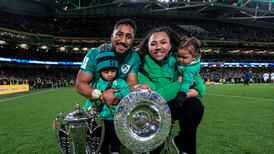A former friend of the man charged with murdering Romanian teenager Marioara Rostas has testified that the accused "danced" on her body after dumping it in a hole dug in the Dublin Mountains.
Fergus O'Hanlon (37), who has immunity from prosecution in the case, was giving evidence yesterday (Friday) in the trial of Dubliner Alan Wilson.
The 35-year-old, of New Street Gardens, has pleaded not guilty to the 18-year-old’s murder at a house on Brabazon Street, The Coombe, Dublin between January 7th and January 8th, 2008.
The teenager disappeared at about 2pm on Sunday, January 6th, after her brother saw her getting into a Ford Mondeo with a man on Lombard Street in the city. Her body was found in a shallow grave on the Wicklow border four years later. She had died of four bullet wounds to the head.
Mr O’Hanlon testified that, in January 2008, he shared a house on Brabazon Street with his then partner and the accused man’s sister, Maxine Wilson.
He told the Central Criminal Court he was out of the house on January 8th but returned home after receiving calls. He said Ms Wilson was nervous and shaking and that Alan Wilson came down the stairs.
“He had a rifle in his hand,” said the witness. “He said: ‘Come here. I want to show you something’.”
He said he and the accused went upstairs to Mr O’Hanlon’s bedroom.
“There was the body of the dead girl there, in the centre of the room, lying on her back, staring at the ceiling,” he said. “She looked like she was wide awake.”
“She had a hole in her forehead and blood running down her nose,” he continued. “I asked who she was.”
He said the accused responded that ‘she was a witness to her brother being killed’.
He said Ms Wilson left the house, as did her brother, who later returned with a lawnmower bag.
The witness said he and the accused undressed the body, wrapped it in clear plastic, folded it over into the shape of a horseshoe and placed it into the bag.
He said the accused put her body into the boot of his Ford Mondeo and drove up the Dublin Mountains, with Mr O’Hanlon lying down in the back seat.
He said they walked uphill, the accused carrying the body and Mr O’Hanlon carrying a shovel.
“Alan started digging a hole. We took it in turns,” he said. “Alan removed her from the green bag and pushed her into the hole.”
“She was stood on a few times. Alan stood on her,” he added. “He was dancing on her.”
He was asked what the purpose of this was, but responded that nothing was said.
He said they travelled back to Brabazon Street, where the accused collected the gun and left.
He said he spent the next few days cleaning his bedroom on the instructions of the accused. He said he dumped the bed and carpet and used bleach to wash the floor and walls.
He said there was still heavy blood staining on the floor boards, skirting and window ledge, and that the accused brought him a belt sander to sand any evidence off the floor.
Under cross-examination by Michael O'Higgins SC, defending, Mr O'Hanlon admitted he was a convicted criminal.
He denied being in the house when Ms Rostas was there alive and said there had been nobody there when he left that morning.
The barrister asked why he had refused to participate in an identification parade in October 2008 when arrested on suspicion of withholding information about the murder.
“I always refuse to go in an ID parade,” he said.
He was asked whether he had ever been violent to a woman. “I wouldn’t call it violence,” he said.
“Did you ever break a couple of your girlfriend’s ribs?” he was asked. He responded that he did so accidentally.
Mr O’Higgins asked whether he had a problem with dark-skinned people, Muslims or non-nationals. “No,” he replied.
He didn’t recall calling hospital security staff ‘Paki b**tards and Muslim racists’ in August 2009.
He denied threatening to shoot them and then shooting them. Mr O’Higgins put it to him that witnesses heard him say that he was going to shoot them and that they were shot on their next shift, 24 hours later.
He was aware of this but said it was nothing to do with him. “It’s a coincidence,” he added.
He said he had handled firearms and seen a lot of them, but said he had never discharged one.
He was asked about the house on Brabazon Street, into which he moved after being released from jail in September 2007.
“Was it a brothel?” he was asked. “No,” he replied.
He also denied it was a “shooting gallery” where people went to take drugs, but agreed a girl had died there of a drug overdose.
Mr O’Hanlon agreed he had been on methadone programmes, where he had to receive daily doses.
The cross-examination continues on Monday before Mr Justice Patrick McCarthy and a jury of 10 men and two women.








